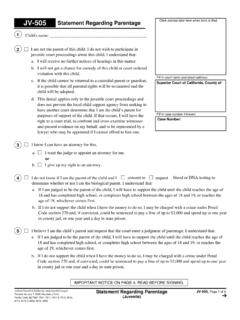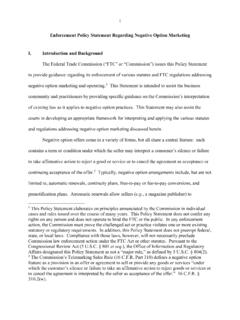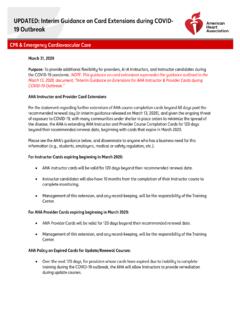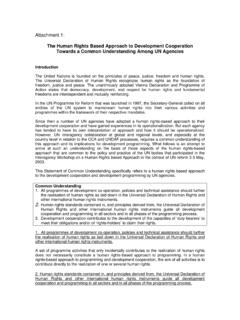Transcription of The ABA Statement on Audit Responses: A Framework that …
1 The ABA Statement on Audit Responses: A Framework that Has Stood the Test of TimeBy Alan J. Wilson, Stanley Keller, Randall D. McClanahan, Noe l J. Para, James , and Thomas W. White, Audit Responses Committee, ABA BusinessLaw Section*This article summarizes key developments in the preparation of Audit response lettersconcerning loss contingencies since the American Bar Association Statement of Policy Re-garding Lawyers Responses to Auditors Requests for Information was published in developments illustrate both the utility of the Framework set forth in the ABA State-ment and the responsiveness of the American Bar Association through the Business LawSection Audit Responses Committee (and predecessor committees) to issues arising underthe ABA Statement and changes in accounting and auditing standards and practice.
2 TheABA Statement , throughout its use, has served two important objectives: (i) to facilitateeffective auditing as the underpinning for public confidence in financial reporting, and(ii) to preserve client confidences as mandated by attorney ethics rules and to protect at-torney-client privilege, each of which is a critical component of our legal system. Withthese objectives in mind, the article highlights some challenges that the legal and account-ing professions have navigated over the past forty-plus years, offering perspectives on thecurrent Framework that should serve as a resource to the legal and accounting professionsgoing has changed since the American Bar Association Statement of Policy Re-garding Lawyers Responses to Auditors Requests for Information (the ABAS tatement )1and the related American Institute of Certified Public Accountants* Alan J.
3 Wilson, Esq., Senior Associate, Wilmer Cutler Pickering Hale and Dorr LLP (Vice Chair,ABA Business Law Section Audit Responses Committee); Stanley Keller, Esq., Senior Partner, LockeLord LLP (Past Chair, ABA Business Law Section Audit Responses Committee); Randall D. McClana-han, Esq., Partner, Butler Snow LLP (Chair, ABA Business Law Section Audit Responses Committee);Noe l J. Para, Esq., Partner, Alston & Bird LLP (Past Chair, ABA Business Law Section Audit ResponsesCommittee); James J. Rosenhauer, Esq., Senior Counsel, Hogan Lovells US LLP (Past Chair, ABAB usiness Law Section Audit Responses Committee); Thomas W. White, Esq., Retired Partner, WilmerCutler Pickering Hale and Dorr LLP (Past Chair, ABA Business Law Section Audit ResponsesCommittee).
4 Of Policy regarding Lawyers Responses to Auditors Requests for Information, (1976),reprinted inABA , AUDITOR SLETTERHANDBOOK1(2d ed. 2013) [hereinafter AUDITOR SLETTERHANDBOOK]. The Statement had been approved in principleby the Section Council in Montreal in August 1975 and, as revised, in early December of Auditing Standards No. 12 ( SAS 12 )2were approved in December1975 and January 1976, respectively. Those statements establish the frameworkfor auditors to obtain information regarding legal claims against the companyunder Audit . Under this Framework , pursuant to SAS 12, the client of the auditorrequests its attorney to provide information regarding such claims, and the attor-ney responds to that request in a letter following the guidance of the adoption of the ABA Statement and SAS 12 over forty years ago, wehave seen an increased emphasis on the quality of loss contingency disclosure,an expansion of private litigation and SEC enforcement actions against accoun-tants and other professionals, a new regulatory regime for the accounting pro-fession established by the Sarbanes-Oxley Act of 2002, the development ofnew technologies to facilitate the Audit letter process.
5 And a substantial changein the standard auditor s report to require disclosure of critical Audit these changes, the ABA Statement has stood the test of time and shownits flexibility to adapt to meet changingcircumstances. Indeed, as this articledemonstrates, since publication of the ABA Statement over forty years ago,there have been relatively few formal statements about it by the AmericanBar Association ( ABA ) or its committees, and no substantive amendmentto ABA Statement provides a Framework designed to balance competing de-mands of the accounting and legal professions, specifically by (i) facilitating ef-fective auditing as the underpinning for public confidence in financial reportingand (ii) preserving client-attorney confidentiality as mandated by attorney ethicsrules and protecting attorney-client privilege.
6 The latter objective is of para-mount societal concern to all lawyers as a primary means to encourage clientconsultation with counsel. The former is of concern, not only as a matter ofan auditor s professional responsibility, but for reliable financial together, these objectives must be pursued flexibly by adjusting to chang-ing business and regulatory demands regarding company financial reporting,and that flexibility should be available without requiring constant amendmentor interpretation. Experience over the past forty-plus years demonstrates thatthis goal has been ABA Statement achieves these objectives by (i) requiring lawyers to iden-tify to auditors pending and threatened claims they are handling, but permittingthem to assess the likely outcome only when an adverse result is either proba-ble or remote (as defined in the ABA Statement ), (ii) limiting when lawyersmay address unasserted claims, and (iii) having lawyers, when appropriate inconnection with their engagement, acknowledge to auditors their professional2.
7 Codification of Statements on Auditing Standards, AU Section 337 (Am. Inst. Certified 1976) (clarified and recodified at Codification of Statements on Auditing Standards, AU-C Section 501 (Am. Inst. Certified Pub. Accountants 2013));see alsoAuditing Standard, AS Section2505 (Pub. Co. Accounting Oversight Bd. 2017). SAS 12 superseded the commentary, Lawyers Let-ters, AU Section 1001 (Am. Inst. Certified Pub. Accountants Jan. 1974), and AICPA Auditing Inter-pretations AU Section Business Lawyer; Vol. 75, Summer 2020responsibility with respect to client disclosures, thereby providing a basis forauditors to know whether lawyers who advise clients on disclosure mattersmeet such responsibility. These basic elements form the structure that governsan otherwise unregulated process involving potentially conflicting demands ofthe legal and accounting LOSSCONTINGENCIESUNDERFAS 5 (RECODIFIEDUNDERFASBASC SUBTOPIC450-20)The present Audit response letter process can be traced back to adoption of themodern-day accounting standards for loss contingency disclosure.
8 In March1975, the Financial Accounting Standards Board ( FASB ) adopted Statementof Financial Accounting Standards ( FAS ) No. 5,Accounting for Contingencies,which was later recodified as FASB Accounting Standards Codification 450-20( ASC 450-20 ).3 FAS 5 set forth consolidated guidance for accounting for con-tingencies, defining a contingency as an existing condition, situation, or set ofcircumstances involving uncertainty as to possible gain .. or loss .. to an en-terprise that will ultimately be resolved when one or more future events occur orfail to occur. 4 Notably, FAS 5 established new standards of financial accountingand reporting for loss contingencies. In this regard, FAS 5 focused on the like-lihood that a future event will occur and defined three terms necessary for nav-igating that future event or events are likely to chance of the future event or events occurring ismore than remote but less than chance of the future event or events occurring is the examples of loss contingencies described in FAS 5 are pending orthreatened litigation and actual or possible claims and assessments, 6whichprovide the basic lens through which companies consider their disclosure obli-gations and as to which auditors are seeking support, including from Fin.
9 Accounting Standards Bd., FASB Statement No. 168, The FASB Accounting Standards Co-dificationTMand the Hierarchy of Generally Accepted Accounting Principles (June 2009), Statement OFFINANCIALACCOUNTINGSTANDARDSNO. 5, at 4 (Fin. Accounting Standards Bd. 1975), acceptedDisclaimer=true. As set forth in the standard, FAS 5 superseded prior contingency guidance in Account-ing Research Bulletin ( ARB ) No. 50 and Chapter 5, Contingency Reserves, of ARB No. ABA Statement on Audit Responses2087 The basic rule under FAS 5 is that an estimated loss from a loss contingencymust be accrued by a charge to income ifbothof the following conditions are met:a. Information available prior to issuance of the financial statements indi-cates that it is probable that an asset had been impaired or a liabilityhad been incurred at the date of the financial ;andb.
10 The amount of loss can be reasonably either of these conditions is not satisfied, or if an exposure to loss exists inexcess of the amount accrued, then footnote disclosure of such conditions mustbe provided when there is at least a reasonable possibility that a loss or an ad-ditional loss may have been incurred. 8 With regard to an unasserted claim orassessment, no disclosure or accrual need be provided when there has beenno manifestation by a potential claimant of an awareness of a possible claimor assessment unless it is considered probable that a claim will be assertedand there is a reasonable possibility that the outcome will be unfavorable. 9 With the adoption of FAS 5 bringing loss contingency accounting into greaterfocus, guidance and procedures became necessary, in recognition that a client slawyers, not its auditors, are in the best position to assess legal matters giving riseto loss contingency accruals or disclosures in a client s financial statements.





